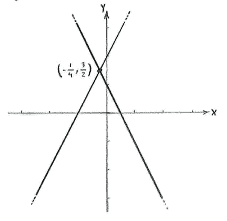Solution 2.2:6e
From Förberedande kurs i matematik 1
m (Lösning 2.2:6e moved to Solution 2.2:6e: Robot: moved page) |
|||
| Line 1: | Line 1: | ||
| + | The lines have a point of intersection at that point which simultaneously satisfies the equations of both lines: | ||
| + | |||
| + | |||
| + | <math>2x+y-1=0</math> | ||
| + | and | ||
| + | <math>y-2x-2=0</math>. | ||
| + | |||
| + | If we make | ||
| + | <math>y</math> | ||
| + | the subject of the second equation | ||
| + | <math>y-2x-2=0</math> | ||
| + | and substitute it into the first equation, we obtain an equation which only contains | ||
| + | <math>x</math>, | ||
| + | |||
| + | |||
| + | <math>2x+\left( 2x+2 \right)-1=0\ \Leftrightarrow \ 4x+1=0</math> | ||
| + | |||
| + | |||
| + | which gives that | ||
| + | <math>x=-{1}/{4}\;</math>. Then, from the relation | ||
| + | <math>y=2x+2</math>, we obtain | ||
| + | <math>y=2\left( -{1}/{4}\; \right)+2={3}/{2}\;</math>. | ||
| + | |||
| + | The point of intersection is | ||
| + | <math>\left( -\frac{1}{4} \right.,\left. \frac{3}{2} \right)</math>. | ||
| + | |||
| + | We check for safety's sake that | ||
| + | <math>\left( -\frac{1}{4} \right.,\left. \frac{3}{2} \right)</math> | ||
| + | really satisfies both equations: | ||
| + | |||
| + | |||
{{NAVCONTENT_START}} | {{NAVCONTENT_START}} | ||
| - | + | ||
| - | + | ||
| - | + | ||
| - | + | ||
{{NAVCONTENT_STOP}} | {{NAVCONTENT_STOP}} | ||
[[Image:2_2_6_e.gif|center]] | [[Image:2_2_6_e.gif|center]] | ||
| + | We check for safety's sake that | ||
| + | <math>\left( -\frac{1}{4} \right.,\left. \frac{3}{2} \right)</math> | ||
| + | really satisfies both equations: | ||
| + | |||
| + | |||
| + | <math>2x+y-1=0</math>: | ||
| + | LHS = | ||
| + | <math>2\left( -\frac{1}{4} \right)+\frac{3}{2}-1=-\frac{1}{2}+\frac{3}{2}-\frac{2}{2}=0</math> =RHS | ||
| + | |||
| + | <math>y-2x-2=0</math>: | ||
| + | LHS = | ||
| + | <math>\frac{3}{2}-2\left( -\frac{1}{4} \right)-2=\frac{3}{2}+\frac{1}{2}-\frac{4}{2}=0</math> =RHS | ||
Revision as of 12:11, 18 September 2008
The lines have a point of intersection at that point which simultaneously satisfies the equations of both lines:
\displaystyle 2x+y-1=0
and
\displaystyle y-2x-2=0.
If we make \displaystyle y the subject of the second equation \displaystyle y-2x-2=0 and substitute it into the first equation, we obtain an equation which only contains \displaystyle x,
\displaystyle 2x+\left( 2x+2 \right)-1=0\ \Leftrightarrow \ 4x+1=0
which gives that
\displaystyle x=-{1}/{4}\;. Then, from the relation
\displaystyle y=2x+2, we obtain
\displaystyle y=2\left( -{1}/{4}\; \right)+2={3}/{2}\;.
The point of intersection is \displaystyle \left( -\frac{1}{4} \right.,\left. \frac{3}{2} \right).
We check for safety's sake that \displaystyle \left( -\frac{1}{4} \right.,\left. \frac{3}{2} \right) really satisfies both equations:
We check for safety's sake that \displaystyle \left( -\frac{1}{4} \right.,\left. \frac{3}{2} \right) really satisfies both equations:
\displaystyle 2x+y-1=0:
LHS =
\displaystyle 2\left( -\frac{1}{4} \right)+\frac{3}{2}-1=-\frac{1}{2}+\frac{3}{2}-\frac{2}{2}=0 =RHS
\displaystyle y-2x-2=0: LHS = \displaystyle \frac{3}{2}-2\left( -\frac{1}{4} \right)-2=\frac{3}{2}+\frac{1}{2}-\frac{4}{2}=0 =RHS

